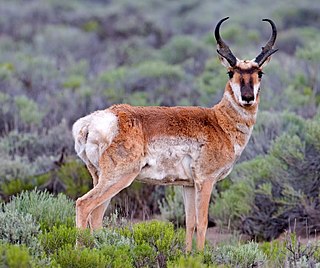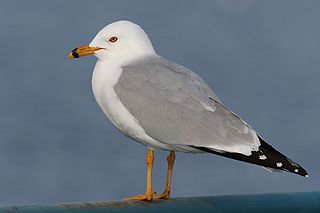 W
WThe pronghorn is a species of artiodactyl mammal indigenous to interior western and central North America. Though not an antelope, it is often known colloquially in North America as the American antelope, prong buck, pronghorn antelope, prairie antelope, or simply antelope because it closely resembles the true antelopes of the Old World and fills a similar ecological niche due to parallel evolution. It is the only surviving member of the family Antilocapridae.
 W
WThe black-tailed prairie dog is a rodent of the family Sciuridae found in the Great Plains of North America from about the United States-Canada border to the United States-Mexico border. Unlike some other prairie dogs, these animals do not truly hibernate. The black-tailed prairie dog can be seen above ground in midwinter. A black-tailed prairie dog town in Texas was reported to cover 25,000 sq mi (64,000 km2) and included 400,000,000 individuals. Prior to habitat destruction, this species may have been the most abundant prairie dog in central North America. This species was one of two described by the Lewis and Clark Expedition in the journals and diaries of their expedition.
 W
WThe bushy-tailed woodrat, or packrat is a species of rodent in the family Cricetidae found in Canada and the United States. Its natural habitats are boreal forests, temperate forests, dry savanna, temperate shrubland, and temperate grassland.
 W
WThe Columbian ground squirrel is a species of rodent common in certain regions of Canada and the northwestern United States. It is the second largest member of the genus Urocitellus, which is part of the tribe Marmotini, along with marmots, chipmunks, prairie dogs, and other holarctic ground squirrels. They are stout, with short dense fur, which is characteristically tawny across the bridge of the nose. Social encounters often are initiated with kissing behavior and the most common activity above ground is standing at attention. Residing in mountainous terrain and high plains in northern latitudes, they hibernate most of the year in burrows, which may be used for many years. They are emaciated when emerging in the spring. These long periods of torpor earned the squirrels the moniker "Seven Sleepers", since the rests last around seven months. The Columbian ground squirrel came to the attention of the scientific community through writings produced by Lewis and Clark, while 21st century molecular genetics has more finely illuminated its ties with other close relatives.
 W
WA cotton rat is any member of the rodent genus Sigmodon. Cotton rats have small ears and dark coats, and are found in North and South America. Members of this genus are distributed in the Southwestern USA, Mexico, Central America and South American countries of: Venezuela, Ecuador, Colombia, Peru, Brazil, Guyana and Suriname. Many of the species are found in Mexico.
 W
WBonaparte's gull is a member of the gull family Laridae found mainly in northern North America. At 28 to 38 cm in length, it is one of the smallest species of gull. Its plumage is mainly white with grey upperparts. During breeding season, Bonaparte's gull gains a slate-grey hood. The sexes are similar in appearance.
 W
WThe ring-billed gull is a medium-sized gull. The genus name is from Latin Larus which appears to have referred to a gull or other large seabird. The specific delawarensis refers to the Delaware River.
 W
WThe hispid cotton rat is a rodent species long thought to occur in parts of South America, Central America, and southern North America. However, recent taxonomic revisions, based on mitochondrial DNA sequence data, have split this widely distributed species into three separate species. The southern edge of the S. hispidus distribution is likely near the Rio Grande, where it meets the northern distribution of S. toltecus. The northern extent of S. hispidus distribution is to the Platte River in Nebraska and from Arizona to Virginia. Adult size is total length 202–340 mm (7.9–13 in); tail 87–122 mm (3.4-4.8 in), frequently broken or stubbed; hind foot 29–35 mm (1-1.3 in); ear 16–20 mm (0.6-0.9 in); mass 50-250 g (1.7-9 oz). They have been used as laboratory animals.
 W
WA pack rat or packrat, also called a woodrat, can be any of the species in the rodent genus Neotoma. Pack rats have a rat-like appearance with long tails, large ears and large black eyes. Pack rats are noticeably larger than deer mice, harvest mice and grasshopper mice, and are usually somewhat larger than cotton rats.
 W
WThe piping plover is a small sand-colored, sparrow-sized shorebird that nests and feeds along coastal sand and gravel beaches in North America. The adult has yellow-orange-red legs, a black band across the forehead from eye to eye, and a black stripe running along the breast line. This chest band is usually thicker in males during the breeding season, and it is the only reliable way to tell the sexes apart. The bird is difficult to see when it is standing still, as it blends well with open, sandy beach habitats. It typically runs in short spurts and stops.
 W
WWilson's plover is a small bird of the family Charadriidae.
 W
WThe pronghorn is a species of artiodactyl mammal indigenous to interior western and central North America. Though not an antelope, it is often known colloquially in North America as the American antelope, prong buck, pronghorn antelope, prairie antelope, or simply antelope because it closely resembles the true antelopes of the Old World and fills a similar ecological niche due to parallel evolution. It is the only surviving member of the family Antilocapridae.
 W
WA cotton rat is any member of the rodent genus Sigmodon. Cotton rats have small ears and dark coats, and are found in North and South America. Members of this genus are distributed in the Southwestern USA, Mexico, Central America and South American countries of: Venezuela, Ecuador, Colombia, Peru, Brazil, Guyana and Suriname. Many of the species are found in Mexico.
 W
WWilson's snipe is a small, stocky shorebird. The genus name gallinago is New Latin for a woodcock or snipe from Latin gallina, "hen" and the suffix -ago, "resembling". The specific delicata is Latin for "dainty".
 W
WThe western gray squirrel is an arboreal rodent found along the western coast of the United States and Mexico. It is a tree squirrel.
 W
WThe tundra swan is a small Holarctic swan. The two taxa within it are usually regarded as conspecific, but are also sometimes split into two species: Bewick's swan of the Palaearctic and the whistling swan proper of the Nearctic. Birds from eastern Russia are sometimes separated as the subspecies C. c. jankowskii, but this is not widely accepted as distinct, with most authors including them in C. c. bewickii. Tundra swans are sometimes separated in the subgenus Olor together with the other Arctic swan species.
 W
WThe meadow vole, sometimes called the field mouse or meadow mouse, is a North American vole found across Canada, Alaska and the northern United States. Its range extends farther south along the Atlantic coast. One subspecies, the Florida salt marsh vole, is found in Florida, and is classified as endangered. Previously it was also found in Chihuahua, Mexico, but has not been recorded since 1998.
 W
WThe eastern woodrat, also known as the Florida woodrat or bush rat is a pack rat native to the central and Eastern United States. It constructs large dens that may serve as nests for many generations and stores food in outlying caches for the winter. While widespread and not uncommon, it has declined or disappeared in several areas.